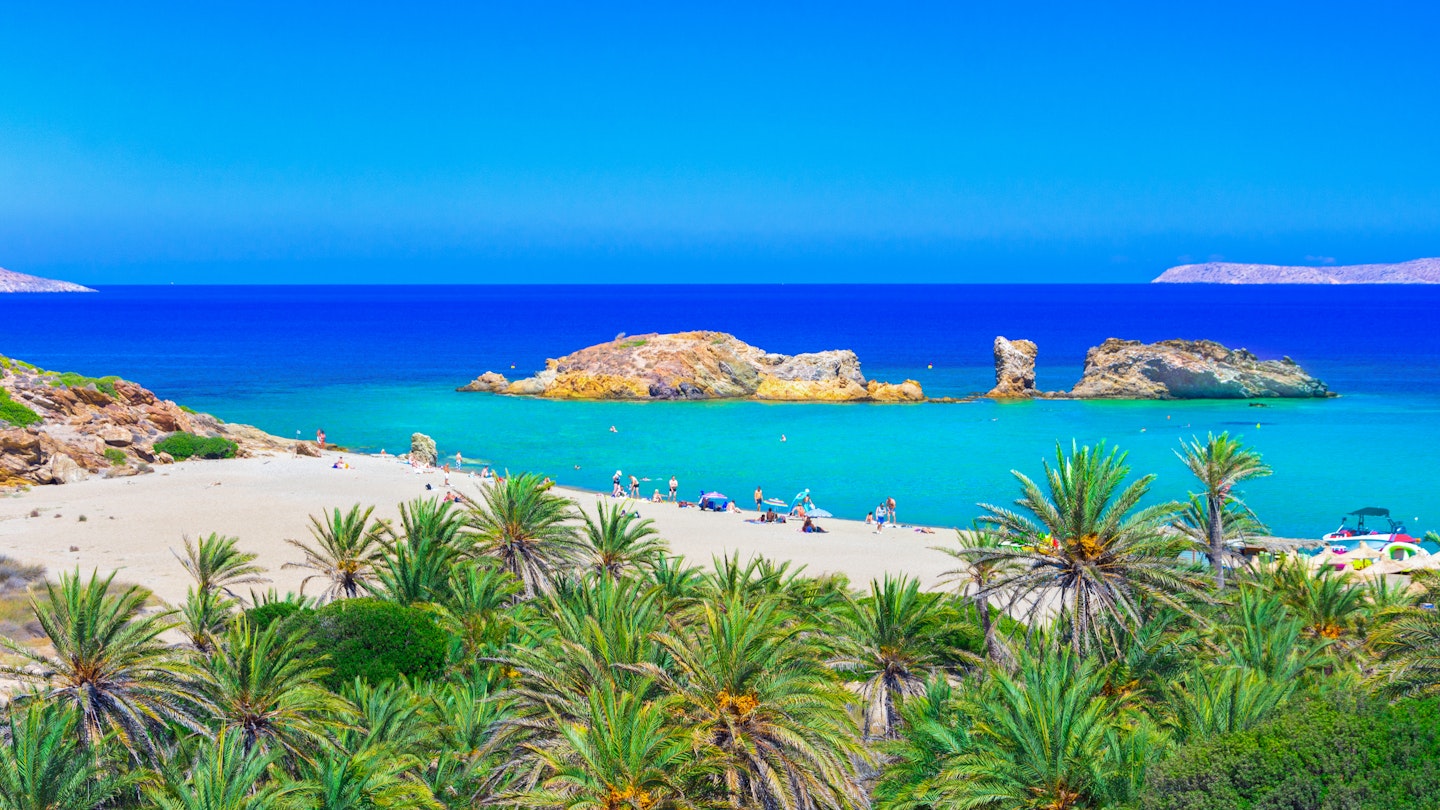Explore the Stunning National Parks of Crete
Much of Crete’s beautiful scenery feels like a natural reserve, which perhaps explains the small number of officially designated natural parks on the island. However, the few that exist all dazzle.
The main national park at Samaria offers one of Europe’s best gorge hikes. Meanwhile, the scenic national park at Vaï, although lacking official facilities, is home to Europe’s only native palm forest.
Other protected areas include the vast region of historic villages and geologic wonders at Psiloritis in central Crete, and the gorgeous gem of Elafonisi Islet on the southwest coast, which offers dreamy walks. All worth a day for exploration and enjoyment, these are the best national parks in Crete.
Catch Shade Under the Rare Palms at Vaï National Park
Don’t expect elaborate entrances or even a rudimentary visitor center at this national park, which exists primarily to preserve Europe’s only native palm forest. Although barely 20 hectares (49 acres) today, as recently as 1957 Vaï boasted a sprawling palm forest that covered over 300 hectares (740 acres) before a local monastery cut down most of the palms for commercial agriculture.
The national government intervened, preserving the remaining palm forest (vaï is Greek for palm) to block substantial development. Consequently, today the area is rich with archaeological sites, small villages, and serene beaches, although the threat of large-scale development remains.
The palm forest stretches down to the Mediterranean in a small valley running perpendicular to the beach. The shady, whispering fronds evoke more tropical climates—a rarity in mostly arid Greece. Secluded coves away from the main beach offer tranquility throughout the year, complemented by various Minoan archaeological sites nearby.
Visiting Vaï National Park: Regular buses reach Vaï from Sitia, located 24 km (15 miles) to the southwest. During summer, the main car park fills up early, so plan to arrive early or visit during other times of the year for a more serene experience.

Hike the Gorge at Samaria National Park
Often referred to as Crete’s sole national park, Samaria National Park serves as the well-organized home to the Samaria Gorge, one of the most popular attractions on the island.
From the park entrance in the hillside village of Xyloskalo, an 18 km (11-mile) trail descends through almost sheer cliffs down to the Mediterranean. Along the way, you’ll pass through 500 m (1600 ft) high rock faces that at times are only 3 m (9 ft) apart. Furthermore, the route features various holy sites and hamlets that were predominantly abandoned when the area was designated a national park.
Stay alert for kri-kri, a mountain goat native to Crete. Moreover, at the trail’s end, few can resist a refreshing dip in the waters at Agia Roumeli.
Visiting Samaria National Park: Organized day trips to the gorge are heavily marketed to tourists across Crete. All tours begin at the park entrance and include pick-ups from either Sougia or Hora Sfakion, seaside villages a short ferry ride from Agia Roumeli.
While it is possible to do this on your own by combining public buses and a ferry ride from Hania, early starts are necessary. In summer, this has the added advantage of getting you on the trail ahead of day-tripping crowds. Therefore, families with older children might especially appreciate the hike.
The park operates from May (occasionally mid-April) to mid-October. Consequently, after midafternoon, visitors are not permitted to complete the entire trail as everyone must exit the park by 4 PM. Sturdy shoes are essential (note the sad faces of those attempting to hike in flip-flops). Water spigots are provided along the way for refills, ensuring you remain hydrated.

Explore the Back Roads of Psiloritis Natural Park
Natural, religious, and cultural splendors await within this expansive UNESCO Global Geopark in central Crete. A highlight is Moni Arkadiou, a significant pilgrimage destination for Cretans and Greeks. This complex includes a surviving grand Venetian church from 1587, which commemorates an uprising against the Ottomans.
The Amari Valley, situated at the south end of the 1159-sq-km (447-sq-mile) park, boasts charming villages scattered across hills lush with olive trees and aromatic herbs. Historic sites abound in the namesake village and the surrounding area. To the north, Margarites is famous for its pottery workshops. After the morning tour groups leave, enjoy a leisurely lunch on a cafe terrace with alp views.
To the northeast, a series of serene caves lie beneath the island’s most dramatic mountain scenery. Melidoni Cave offers both historical significance, linked to Ottoman atrocities, and geologic beauty with its stunning formations.
Visiting Psiloritis Natural Park: The park encompasses a wide area rather than a defined reserve. The numerous sights are easily accessible by car from Rethymno and Iraklio, and driving through the winding roads amid the geological splendor is one of Crete’s highlights. However, bus service between smaller towns like Margarites is limited.

Walk Across the Water to Elafonisi Islet
The dazzling pink-white sands of Elafonisi on Crete’s southwest coast have garnered fame; however, during high season, the strands can become crowded with numerous umbrellas shielding sunbathers. Fortunately, an escape lies merely 50m (164ft) offshore.
Elafonisi Islet is connected to the main beach via a sandy isthmus that appears at low tide. When the Mediterranean level rises, expect at most a refreshing wade through knee-high water to reach this stunning dune-covered land. Even when the beach is packed, the islet remains largely untouched by crowds—making it popular among nudists. Climbing to the highest point rewards you with breathtaking views of turquoise waters, white sand, and rose-hued dunes. The entire islet is a protected natural area, providing a refreshing respite from the bustle of Crete.
Visiting Elafonisi Islet: Throughout much of the year, Elafonisi’s main beach is most easily reached by car; however, in summer, very limited bus and ferry services are available. Expect fewer visitors outside the May to September window, while winter brings its own adventures, including bracing temperatures and breezy waves as you walk across the water.




